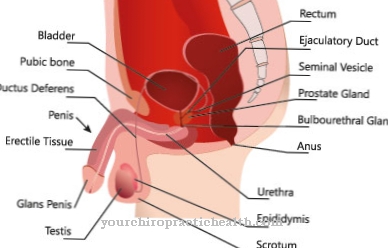Lots of people who attend Incontinence or specifically one Urinary incontinence (Latin: Incontinentia urinae) suffer, are ashamed of their illness. But in Germany around 6 to 8 million people are affected, women more often than men. Incontinence is characterized by various symptoms and can also be the result of a wide variety of diseases.
What is incontinence (urinary incontinence)?
.jpg)
Incontinence can take many forms. Common to all of them are problems with holding and self-determined delivery of urine. The likelihood of more severe forms of incontinence increases with age.
With urinary incontinence, the patient feels the sudden need to empty his bladder. In stress incontinence, stress (coughing, sneezing, etc.) triggers an involuntary loss of urine.
In severe cases, simply standing up or even lying down can be a burden. Overflow incontinence is a characteristic of unintentional dripping of urine. With reflex incontinence, the patient may lose urine without realizing it.
causes
A Incontinence can have many causes depending on the type of incontinence. In the case of urinary incontinence, the patient has increased bladder sensitivity. The urinary bladder (detrusor) is permanently contracted and the patient feels the urge to urinate without the bladder being full.
Stress incontinence can be caused, among other things, by a functional weakness of the urinary obstruction system. But especially in women, incontinence can also be caused by a weak pelvic floor. This weakness often arises as a result of a general sagging of the internal organs due to weak ligaments and muscles, and can result from sudden childbirth.
The unconscious incontinence is characterized by flow obstruction. These can be caused by an enlarged prostate. However, incontinence can also be caused by neurological diseases, diabetes or other reasons.
Symptoms, ailments & signs
Urinary incontinence can have different symptoms depending on the type and cause. Stress incontinence can be recognized by the fact that the involuntary loss of urine occurs predominantly during physical exertion. The loss of urine can vary in severity and typically occurs without a prior urge to urinate.
Urge incontinence manifests itself as an acute, excessive urge to urinate before the urine suddenly passes. This type of incontinence can occur several times an hour, even if the bladder is not yet full. Overflow incontinence causes small amounts of urine to leak out. The patients usually feel dripping and a permanent need to urinate.
Reflex incontinence is associated with irregular emptying of the bladder. Patients can no longer tell whether the bladder is full and usually do not empty the bladder completely. With extraurethral incontinence, urine is constantly lost. This can be accompanied by pain in the ureter and bladder area.
In small children, urinary incontinence is noticeable in that it occurs at irregular intervals and subsides by the age of four. If the symptoms persist well beyond the age of four, there is another form of urinary incontinence that must be diagnosed and treated by a doctor.
Course of disease
A treatment of the Incontinence in many cases is not only important for the patient's worth, but can also be medically indicated.
In the most severe cases, failure to treat incontinence can even lead to urinary poisoning (uremia), particularly with overflow bladders.
The urine remaining in the bladder accumulates in the ureters and kidneys and causes an increasing loss of function of the kidneys (renal insufficiency). This can then lead to urinary poisoning with severe consequences.
But the treatment of incontinence is also important in other cases. Incontinence can also be a symptom of another more serious condition, such as prostate cancer or diabetes. These diseases, which are accompanied by incontinence, usually worsen without treatment and can be fatal.
Complications
Urinary incontinence can be treated or managed well today. But it also tends to offer space for various complications. Skin irritation may occur if urine comes into frequent contact with the skin. If left untreated, ulcers and inflammation can develop, especially in elderly or bedridden people.
The risk of a urinary tract infection is also increased with incontinence. In addition, those affected often feel embarrassed by their inability to hold their urine. In some cases, those affected can no longer hold a bowel movement. But even urinary incontinence can be an occasion for many to withdraw from other people. They fear that the consequences of incontinence will cause them to become a disruptive factor in social life.
Mental problems can arise as a complication of incontinence due to surgery in younger years. Depression or anxiety can put an additional burden on those affected. In addition, not everyone has the opportunity to get the necessary incontinence pads and aids.
Surgery can help with postpartum stress incontinence or hysterectomy. However, such operations can also lead to complications. Therefore, an attempt is first made with pelvic floor exercises to counteract urinary incontinence with a conservative treatment approach. Depending on the surgical method, wound healing disorders can occur. The operation can lead to bleeding, urinary tract infections, and nerve irritation and damage. Peritonitis is possible but less common.
When should you go to the doctor?
Many patients with urinary or fecal incontinence avoid going to the doctor out of shame or fear of possible examinations. Nevertheless, those affected who can no longer hold their urine or stool should seek examination and advice as soon as possible. This is also recommended if it is only a mild form of urinary incontinence. As a rule, incontinence can be treated well after medical advice. Which type of therapy is suitable for the person affected can only be determined if the attending physician can determine the exact form of the incontinence by means of examinations.
In some cases, incontinence may worsen significantly without treatment. It usually does not go away on its own. Sometimes incontinence can be a symptom of serious illnesses. For this reason, it is advisable to consult a doctor as soon as possible after the onset of symptoms. The earlier the person concerned takes such measures, the higher the chances of recovery. It is advisable to consult your family doctor first.
Treatment & Therapy
Treatment of the Incontinence must always be based on the causes. The patient should seek advice from a doctor. If the pelvic floor is weak, the first goal is of course to strengthen the pelvic floor muscles. This can be reinforced through a variety of exercises.
Sometimes the support of biofeedback is necessary so that the patient learns to control the muscle movements. To do this, a probe is inserted that shows which muscle is being tensed at the moment. Occasionally, estrogen treatment or, in severe cases, the formation of an artificial sphincter is useful for stress urinary incontinence. In the case of urge incontinence, in mild cases, bladder teas, medication made from herbal ingredients and heat treatment can have an effect.
You can also reduce incontinence with toilet training. To do this, the patient goes to the toilet at predetermined times and thus anticipates the urge. In more severe cases, advice can also be given about the administration of stronger medication against incontinence.
In many cases, unconscious incontinence can be alleviated with herbal medicines made from pumpkin, nettle or saw palmetto. In severe cases, the administration of an alpha receptor blocker is also useful. This loosens the bladder blockage and lowers the flow resistance and can thus fight incontinence.
You can find your medication here
➔ Medicines for bladder and urinary tract healthOutlook & forecast
The prognosis of incontinence depends on the age of the patient and the underlying disease. Depending on the disorder present, spontaneous healing or chronic disease development can occur.
In children, incontinence occurs in the natural growth and development process during night sleep. The control over the sphincter must first be trained sufficiently before it functions properly. It is a temporary phenomenon with sporadic occurrence that usually occurs up to the age of six. During this time, there may be phases of freedom from symptoms. A spontaneous end of the wetting can then be expected.
In older people, the muscles naturally weaken to a certain extent. Incontinence develops, which in most cases lasts until the end of life. There is no prospect of a cure in these patients.
If incontinence is triggered by paralysis or a viral disease, the prognosis of the causative disease must be considered. This is decisive for the further course and the prospect of an alleviation or healing of the symptoms. If existing germs can be found and treated with medication, recovery occurs within a few days or weeks. If the muscles are paralyzed, freedom from symptoms is often no longer possible.
prevention
Home remedies ↵ for incontinence Strengthening the pelvic floor muscles is an effective prevention, especially for women Incontinence Special exercises are offered in many adult education centers or sports clubs.
But a healthy lifestyle also reduces the risk of incontinence considerably. In general, to prevent incontinence, one should eat a healthy diet, refrain from smoking, and combat any obesity.
Aftercare
Patients need extensive support with incontinence care in their everyday life. Continuous monitoring and advice by a specialist and trained medical staff in the field of ostomy care and therapy is important here. In order not to always have the fear of an ailment in everyday life, the use of suitable templates, inserts or diaper pants is necessary and recommended for patients.
The templates are characterized by size and absorbency and are therefore differentiated for day and night use. With appropriate expert advice, the patient will find the right incontinence material for them to get through the day and through the night as far as possible without restriction. A timely change of the incontinence material for the patient is necessary, however, in order to avoid unpleasant smells or visible things.
With an individually adapted incontinence supply, participation in social life is almost unrestricted. Measures and therapies that can improve continence in the long term should also take effect. This includes strengthening the muscles through targeted pelvic floor training. For this, however, the patients need patience, initiative and perseverance. An improvement may take weeks or months, as the muscles first have to strengthen and develop.
You can do that yourself
Targeted gymnastics exercises strengthen the pelvic floor muscles and can significantly reduce the involuntary leakage of urine in mild forms of incontinence. However, they must be carried out consistently and permanently in order to achieve a long-lasting effect. The reduction of obesity and a high-fiber diet also have a positive effect on the pelvic floor muscles.
In many cases, bladder training is helpful, in which the urinary bladder is emptied regularly at certain times before the urge to urinate begins. Nocturnal urine leakage can often be avoided with one or two scheduled visits to the toilet. Drinking less if you have urinary incontinence is usually counterproductive: the urinary tract is no longer adequately flushed due to the reduced amount of urine, and bacteria can multiply and cause urinary tract infections. These in turn cause a constant urge to urinate, which in turn is accompanied by uncontrolled urination.
In order not to slide into social isolation, those affected should continue their everyday life as normally as possible despite the urinary incontinence and also not forego their usual leisure activities: Discreet but very absorbent pads provide security at work and during sports, with special incontinence swimwear Swimming pool visits possible without any problems. Anyone who suffers severely from incontinence psychologically should not be afraid to talk to a psychologist, psychotherapist or join a self-help group.




.jpg)
.jpg)


















.jpg)



